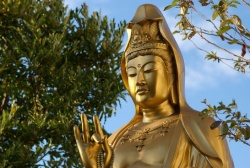Difference between revisions of "Shingon"
(Created page with "thumb|250px| <poem> Shingon shū (jap. 真言宗, literally: School of the true word, is meant: School of the Mantra) is one of Kūkai (空海, 774 - 835...") |
|||
| (4 intermediate revisions by the same user not shown) | |||
| Line 1: | Line 1: | ||
[[File:1546-hd.jpg|thumb|250px|]] | [[File:1546-hd.jpg|thumb|250px|]] | ||
<poem> | <poem> | ||
| − | Shingon shū (jap. 真言宗, literally: School of the true word, is meant: School of the Mantra) is one of Kūkai (空海, 774 - 835) - called Kōbō Daishi (弘法大師, large master | + | [[Shingon]] [[shū]] (jap. [[真言宗]], literally: [[School of the true word]], is meant: [[School of the Mantra]]) is one of [[Kūkai]] ([[空海]], 774 - 835) - called [[Kōbō Daishi]] ([[弘法大師]], large [[master]] that Training spreading) - in the year 807 created school of the [[Japanese Buddhism]] , after it had been sent by {{Wiki|emperor Kammu}} into the [[Empire]] of [[China]] and had studied some years there. This [[Form]] of the [[Buddhism]] is general in [[Japan]] as [[Mikkyo]] admits, what “[[secret teachings]]” or “[[secret Buddhism]]” means. |
| − | It has its roots in the Chinese Mizong (密宗, | + | It has its [[roots]] in the {{Wiki|Chinese}} [[Mizong]] ([[密宗]], [[Esoteric school]]) or [[Zhenyan]] and/or. [[Sanskrit]] [[Vajrayana]] or [[Tantra]] and ranks among the most important [[directions]] of the [[Buddhism]] in [[Japan]]. |
| − | To | + | To their {{Wiki|Characteristics}} count: |
| − | Historically Buddha Siddhartha Gautama admitted of Vairocana beside that the admiration of the cosmic Buddha ( Adibuddha) | + | Historically [[Buddha]] [[Siddhartha]] [[Gautama]] admitted of [[Vairocana]] beside that the admiration of the [[cosmic Buddha]] ( [[Adibuddha]]) |
| − | also in Japan as particularly complicate valid training building | + | also in [[Japan]] as particularly complicate valid {{Wiki|training}} building |
| − | and the frequent use of Mantras, as | + | and the frequent use of [[Mantras]], as „[[Mental]] keys “outstanding {{Wiki|syllables}}, during the [[Meditation]]. |
| − | Hauptsutren are Dainichi kyo and Kongocho gyo, in which first systematics of teachings and practice of the Mikkyo are summarized. | + | Hauptsutren are [[Dainichi kyo]] and [[Kongocho gyo]], in which first systematics of teachings and [[practice]] of the [[Mikkyo]] are summarized. |
| − | In the west as the west often as | + | In the [[west]] as the [[west]] often as “[[Tantra]]” did not designate, but so the actual term of the [[Tantra]] really or at least not completely meeting become known practices are unknown in the [[Japanese]] [[Shingon]]. |
| − | A center is the Koyasan, a mountain with a temple city in the prefecture Wakayama. | + | A center is the [[Koyasan]], a mountain with a [[temple]] city in the prefecture Wakayama. |
</poem> | </poem> | ||
{{R}} | {{R}} | ||
Latest revision as of 17:59, 11 March 2015
Shingon shū (jap. 真言宗, literally: School of the true word, is meant: School of the Mantra) is one of Kūkai (空海, 774 - 835) - called Kōbō Daishi (弘法大師, large master that Training spreading) - in the year 807 created school of the Japanese Buddhism , after it had been sent by emperor Kammu into the Empire of China and had studied some years there. This Form of the Buddhism is general in Japan as Mikkyo admits, what “secret teachings” or “secret Buddhism” means.
It has its roots in the Chinese Mizong (密宗, Esoteric school) or Zhenyan and/or. Sanskrit Vajrayana or Tantra and ranks among the most important directions of the Buddhism in Japan.
To their Characteristics count:
Historically Buddha Siddhartha Gautama admitted of Vairocana beside that the admiration of the cosmic Buddha ( Adibuddha)
also in Japan as particularly complicate valid training building
and the frequent use of Mantras, as „Mental keys “outstanding syllables, during the Meditation.
Hauptsutren are Dainichi kyo and Kongocho gyo, in which first systematics of teachings and practice of the Mikkyo are summarized.
In the west as the west often as “Tantra” did not designate, but so the actual term of the Tantra really or at least not completely meeting become known practices are unknown in the Japanese Shingon.
A center is the Koyasan, a mountain with a temple city in the prefecture Wakayama.
